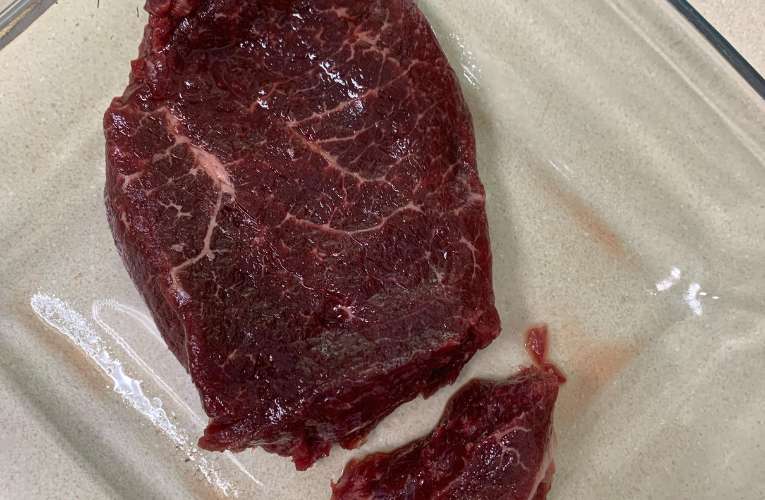Thawing steak can sometimes lead to it turning brown, which can be a cause for concern. However, this discoloration is typically a natural process called oxidation and does not necessarily mean that the steak is spoiled.
When meat is exposed to air, the iron in it reacts with oxygen, resulting in a change in color. While the brown color might not look appealing, the steak should still be safe to consume as long as it was properly stored and thawed.
However, if there are any other signs of spoilage, such as a foul smell or slimy texture, it is best to discard the steak.
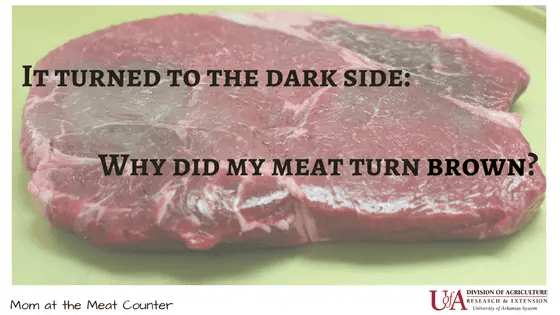
Proper Thawing Techniques
Thawing steak is an essential step to ensure its quality and taste. Improper thawing methods can result in browning and loss of color, which can negatively impact the appearance and taste of the steak.
In this section, we will discuss the best methods to thaw steak to prevent browning and maintain its color.
1. Refrigerator Thawing:
One of the safest and most effective methods to thaw steak is by using the refrigerator. This method allows for a gradual thawing process, which helps preserve the steak’s color and texture. Here’s how to do it:
- Place the frozen steak on a plate or tray to catch any drips.
- Place the steak in the refrigerator on the bottom shelf to prevent cross-contamination.
- Allow the steak to thaw for approximately 24 hours for every 2 pounds of meat. Thicker cuts may require more time.
- Once thawed, use the steak within 3-5 days.
2. Cold Water Thawing:
If you need to thaw the steak quickly, cold water thawing is a viable option. This method helps maintain the color of the steak while speeding up the thawing process. Follow these steps:
- Place the frozen steak in a leak-proof plastic bag to prevent water from seeping in.
- Fill a large bowl or sink with cold water.
- Submerge the bagged steak in the water, ensuring that it is completely submerged.
- Change the water every 30 minutes to maintain the cold temperature.
- Thawing time varies depending on the size of the steak. As a general guideline, allow 30 minutes per pound.
- Once thawed, cook the steak immediately.
3. Microwave Thawing:
Microwave thawing is a quick method for thawing steak, but it should be used as a last resort. This method can result in uneven thawing and partial cooking of the steak, leading to color loss. If you choose to use a microwave, follow these steps:
- Remove any packaging or wrapping from the steak.
- Place the steak on a microwave-safe plate.
- Set the microwave to the defrost setting or 50% power.
- Thaw the steak in short intervals, rotating and flipping it to promote even thawing.
- Once thawed, cook the steak immediately to prevent any food safety risks.
4. Avoid Thawing at Room Temperature:
Thawing steak at room temperature is not recommended as it can lead to bacterial growth and spoilage. It also increases the risk of browning and loss of color. Always opt for safe thawing methods such as refrigerator thawing, cold water thawing, or microwave thawing.
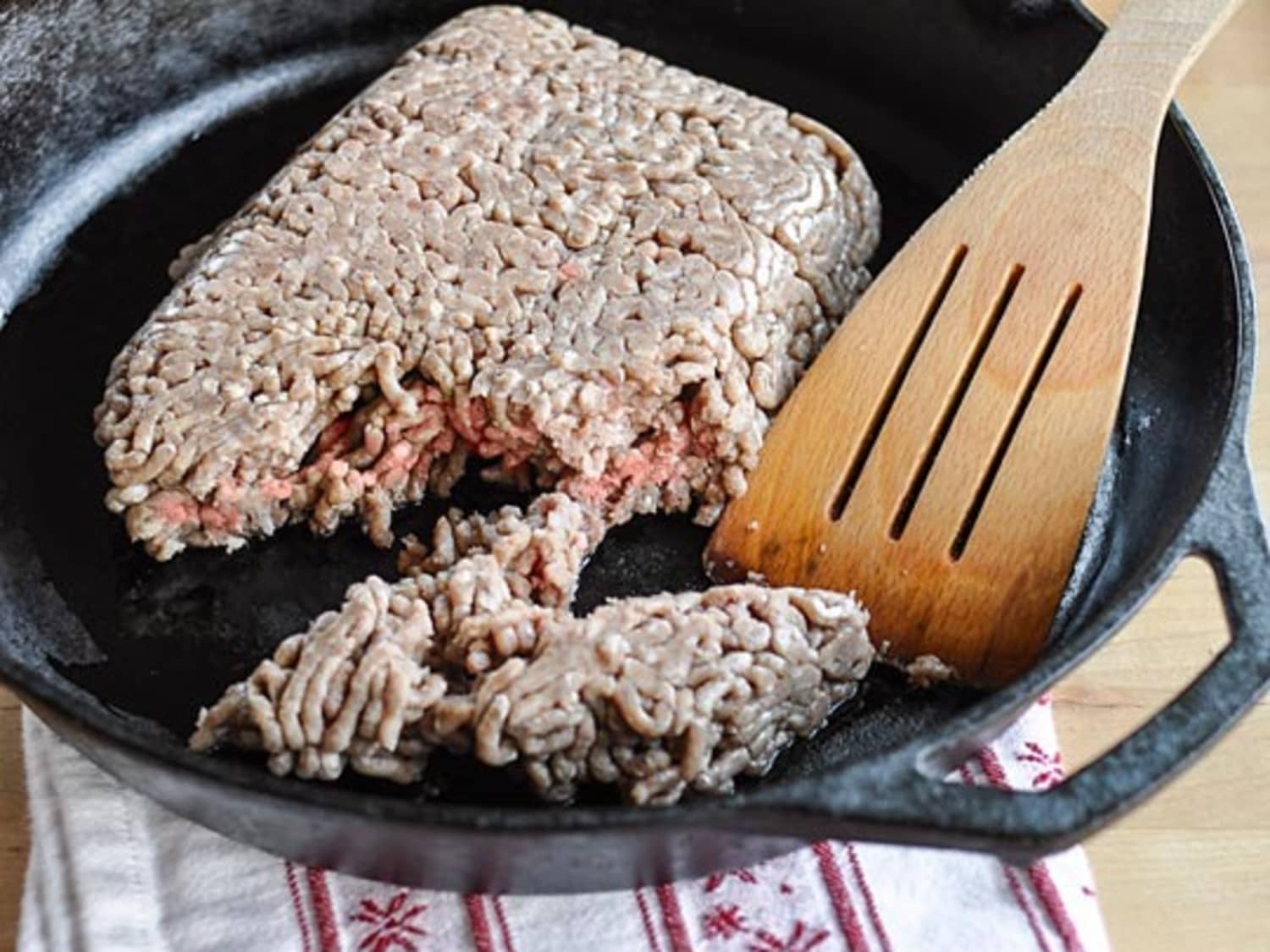
Factors Affecting Steak Browning
When thawing a steak, there are several factors that can contribute to the browning process. Understanding these factors can help you achieve the desired level of browning and ensure that your steak is cooked to perfection.
Let’s explore some of the key factors that affect steak browning during thawing.
1. Temperature
The temperature at which you thaw your steak plays a crucial role in the browning process. When steak is exposed to higher temperatures, the Maillard reaction occurs more rapidly, resulting in a deeper browning effect.
On the other hand, if the temperature is too low, the browning process may be slower or insufficient.
It is recommended to thaw your steak in the refrigerator at a temperature of around 40°F (4°C). This allows for a gradual thawing process, ensuring that the steak retains its moisture and achieves an even browning effect.
2. Air Circulation
Adequate air circulation around the steak during thawing is another important factor in achieving optimal browning. Air circulation helps to remove moisture from the surface of the steak, allowing the Maillard reaction to take place more effectively.
When thawing steak, it is best to place it on a wire rack or a plate with raised edges. This allows air to circulate around the steak, promoting even browning and preventing the buildup of excess moisture.
3. Surface Moisture
The presence of excess surface moisture on the steak can hinder the browning process. Moisture acts as a barrier, preventing the Maillard reaction from occurring and resulting in less desirable browning.
Prior to thawing, it is advisable to pat the steak dry using a paper towel. This helps to remove any excess moisture and allows for better browning during the cooking process.
4. Time
The duration of the thawing process can also influence the browning of the steak. Thawing too quickly or for an extended period can affect the browning process and result in uneven browning.
For best results, it is recommended to thaw the steak in the refrigerator overnight or for a few hours, depending on the size of the steak. This allows for a controlled thawing process and ensures that the steak browns evenly when cooked.
5. Fat Content
The fat content of the steak can impact the browning process. Steaks with higher fat content tend to brown more quickly due to the increased presence of fat, which enhances the Maillard reaction.
If you prefer a more pronounced browning effect, opt for steaks with a higher fat content, such as ribeye or striploin. Leaner cuts, like filet mignon, may require additional cooking techniques to achieve the desired level of browning.
6. Cooking Method
The cooking method you choose can also affect the browning of the steak during the thawing process. Different cooking methods, such as grilling, searing, or broiling, can produce varying levels of browning.
Grilling and searing at high temperatures are known to create a rich, caramelized crust on the steak, resulting in a deeper browning effect. On the other hand, broiling may yield a lighter browning due to the shorter cooking time and lower heat intensity.
7. Seasonings and Marinades
The use of seasonings and marinades can contribute to the browning of the steak by introducing additional flavor compounds that enhance the Maillard reaction.
Seasonings like salt, pepper, and spices can create a savory crust on the steak, while marinades containing acidic ingredients like vinegar or citrus juices can help break down proteins and promote browning.
It is important to note that excessive seasoning or prolonged marinating times can lead to excessive browning or a mushy texture. Therefore, it is essential to use seasonings and marinades in moderation.
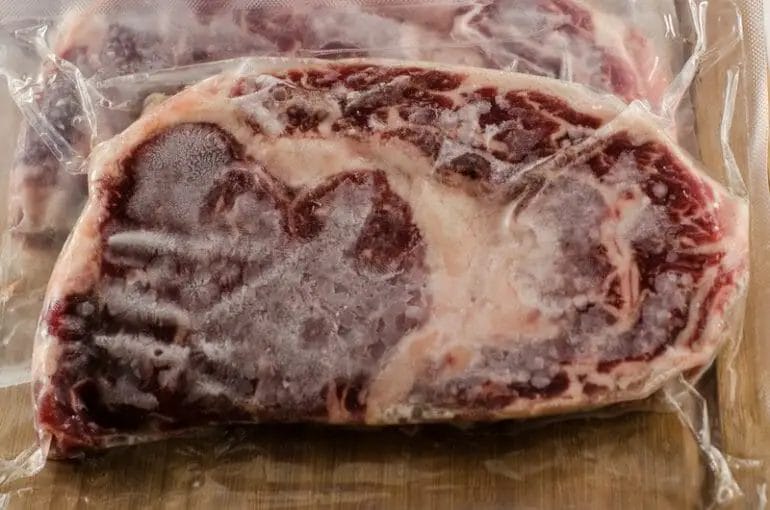
Tips to Prevent Steak Browning
When it comes to cooking a delicious steak, presentation is key. One common issue that many people face is the browning of steaks after thawing. This can affect the overall appearance and make the steak look less appetizing.
However, with a few simple tips and tricks, you can prevent steak browning and keep your meat looking fresh and delicious.
1. Proper Storage
Start by ensuring that you store your steaks properly. When thawing, it is important to keep the meat in a controlled environment to prevent browning.
Make sure to place the steaks in an airtight container or wrap them tightly in plastic wrap to minimize exposure to air. This will help maintain the color of the meat and prevent it from oxidizing.
2. Quick Thawing
Instead of leaving your steaks to thaw at room temperature, opt for a quick thawing method. Thawing the steaks in the refrigerator overnight is the ideal method as it allows for a slow and controlled thaw.
However, if you’re short on time, you can use the cold water thawing method. Simply place the steaks in a sealed plastic bag and submerge them in cold water.
Replace the water every 30 minutes until the steaks are fully thawed. Avoid using hot water as it can lead to uneven cooking and browning.
3. Acidic Marinade
An acidic marinade can help prevent steak browning. The acid in the marinade can slow down the browning process by inhibiting the enzyme responsible for the discoloration.
Consider marinating your steaks in a mixture of vinegar, citrus juice, or wine for at least 30 minutes before cooking. This not only adds flavor but also helps maintain the appearance of the meat.
4. Use Lemon Juice
If you don’t have time to marinate your steaks, a simple trick is to squeeze some lemon juice over them. Lemon juice contains citric acid, which can act as a natural inhibitor of browning. Gently rub the lemon juice onto the surface of the steaks before cooking to help prevent discoloration.
5. Keep It Cool
When cooking your steaks, it’s important to keep the temperature low to prevent excessive browning. High heat can cause the maillard reaction, which results in browning.
Start by searing the steaks over high heat for a short period of time to lock in the juices, then reduce the heat to a medium or medium-low setting for the remaining cooking time. This will help minimize browning and ensure a perfectly cooked steak.
6. Sear at the End
Another tip to prevent steak browning is to sear the meat at the end of the cooking process.
Instead of searing the steaks at the beginning, which can increase browning, cook the steaks until they are almost done and then sear them quickly at a high temperature to achieve a nice crust. This will help preserve the color and prevent excessive browning.
7. Resting Period
After cooking your steaks, allow them to rest for a few minutes before serving. This resting period allows the juices to redistribute throughout the meat, resulting in a juicier steak. During this time, cover the steaks with aluminum foil to retain the heat and prevent further browning.
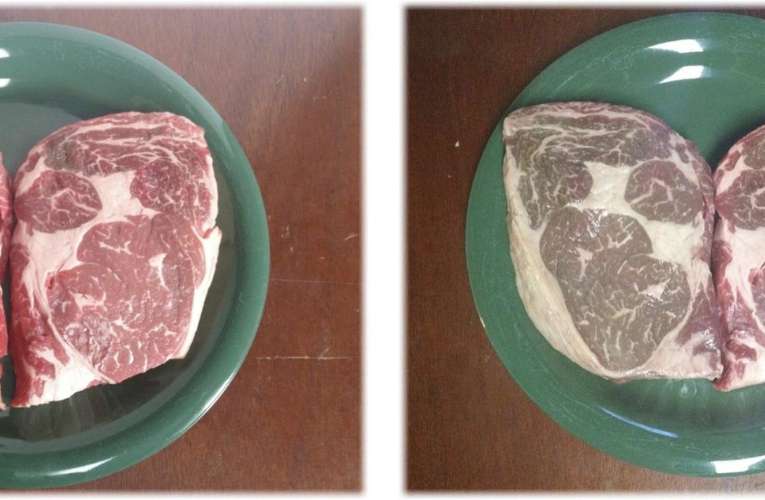
The Impact of Browning on Flavor and Texture
When it comes to cooking steak, achieving the perfect flavor and texture is key. However, one factor that can greatly influence the taste and mouthfeel of thawed steak is browning.
Browning occurs when proteins and sugars in the steak react with heat, resulting in a desirable golden-brown color and the formation of flavorful compounds.
In this section, we will explore the impact of browning on flavor and texture and provide tips on how to mitigate its effects for a delicious steak experience.
1. Browning and Flavor Enhancement
Browning plays a crucial role in enhancing the flavor profile of thawed steak. When the steak is exposed to high heat, the Maillard reaction takes place, which leads to the formation of savory and aromatic compounds.
These compounds contribute to the rich, caramelized flavors that are often associated with well-cooked steaks.
During the Maillard reaction, amino acids and reducing sugars in the steak undergo a series of complex chemical reactions.
This reaction creates a range of flavorful compounds, including pyrazines, pyrroles, and furans, which add depth and complexity to the taste of the steak. The longer and hotter the browning process, the more intense the flavors become.
2. Browning and Texture Changes
Browning also has a significant impact on the texture of thawed steak. As the steak browns, the outer surface undergoes a transformation, forming a crust that adds a desirable crispiness and texture contrast to the tender interior.
Moreover, browning can also influence the moisture content of the steak. When proteins react with heat, they undergo denaturation, causing the muscle fibers to contract and squeeze out moisture.
This can result in a juicier and more succulent steak. However, excessive browning can lead to overcooking, resulting in a dry and tough texture.
3. Mitigating the Effects of Browning
While browning can enhance the flavor and texture of thawed steak, it is important to control the process to achieve the desired results. Here are some tips to mitigate the effects of browning:
- Pat dry the thawed steak before cooking to minimize the moisture on the surface, allowing for better browning.
- Preheat the cooking surface to a high temperature to promote browning and achieve a flavorful crust.
- Use a cooking oil with a high smoke point, such as vegetable or canola oil, to prevent burnt flavors.
- Monitor the cooking time and temperature to avoid excessive browning and overcooking the steak.
- Consider using marinades or dry rubs with ingredients like sugar and spices to enhance browning and add extra flavor.
By following these tips, you can harness the benefits of browning while maintaining the desired flavor and texture of your thawed steak.
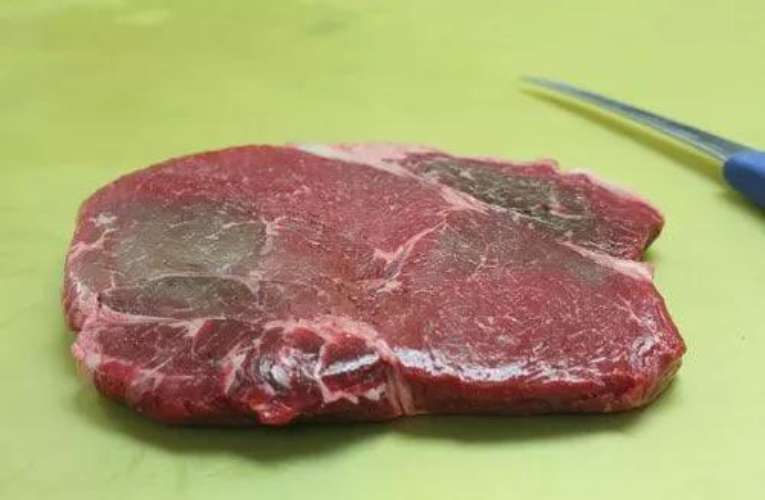
FAQs
Why is my steak brown after thawing?
When meat is thawed, it may turn brown due to a process called oxidation. Oxygen in the air reacts with the meat’s myoglobin, causing the brown color.
This is a natural occurrence and does not indicate spoilage. The steak is still safe to eat as long as it has been properly thawed and stored.
Final Thoughts
In conclusion, if you notice that your thawed steak has turned brown, it is likely due to a natural process called oxidation. When the steak is exposed to air, the iron in the meat reacts with oxygen, causing a color change.
While the browning may affect the appearance, it does not necessarily mean that the steak is no longer safe to consume. However, if there is a foul odor or the texture feels slimy, it may indicate spoilage, and it is advisable to discard the steak.
To prevent browning, you can minimize exposure to air by storing the thawed steak in an airtight container or wrapping it tightly in plastic wrap before refrigerating.
Remember, proper thawing techniques and storage practices can help maintain the quality of your steak and ensure a delicious dining experience. Enjoy your meal!

